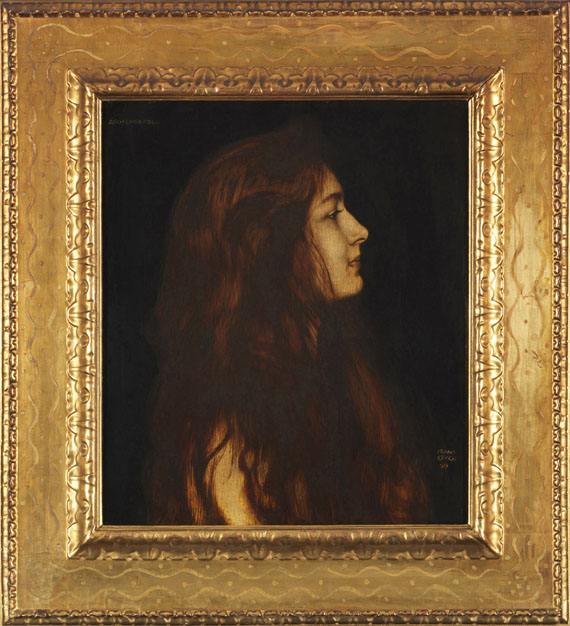19
Franz von Stuck
Aschenbrödel, 1899.
Oil on panel
Estimate:
€ 80,000 / $ 94,400 Sold:
€ 131,250 / $ 154,875 (incl. surcharge)
Aschenbrödel. 1899.
Oil on panel, partly cradled.
Voss 193. Lower right signed and dated, upper left titled. 49.1 x 42.3 cm (19.3 x 16.6 in).
Verso with old label remains and several numbers by a later hand other. Artist's original frame, verso with a label of the frame maker Hans Irlbacher, Munich. [CB].
PROVENANCE: Christie's, London, German and Austrian Art, 13 October 1994, lot 50 (with color illu.).
EXHIBITION: Franz von Stuck. Meisterwerke der Malerei, Villa Stuck, Munich, 4 December 2008 to 15 March 2009, cat. no. 50 (with color illu.).
Horizont Jawlensky. Alexander Jawlensky im Spiegel seiner künstlerischen Begegnungen 1900-1914, Museum Wiesbaden,14 February to 1st June 2014, Kunsthalle Emden, 21st June to 19 October 2014, cat. no. 161 (with color illu. on p. 18).
LITERATURE: Franz von Stuck. Das Gesamtwerk, preface by Fritz von Ostini, Munich 1909, illu. on p. 75.
Oil on panel, partly cradled.
Voss 193. Lower right signed and dated, upper left titled. 49.1 x 42.3 cm (19.3 x 16.6 in).
Verso with old label remains and several numbers by a later hand other. Artist's original frame, verso with a label of the frame maker Hans Irlbacher, Munich. [CB].
PROVENANCE: Christie's, London, German and Austrian Art, 13 October 1994, lot 50 (with color illu.).
EXHIBITION: Franz von Stuck. Meisterwerke der Malerei, Villa Stuck, Munich, 4 December 2008 to 15 March 2009, cat. no. 50 (with color illu.).
Horizont Jawlensky. Alexander Jawlensky im Spiegel seiner künstlerischen Begegnungen 1900-1914, Museum Wiesbaden,14 February to 1st June 2014, Kunsthalle Emden, 21st June to 19 October 2014, cat. no. 161 (with color illu. on p. 18).
LITERATURE: Franz von Stuck. Das Gesamtwerk, preface by Fritz von Ostini, Munich 1909, illu. on p. 75.
19
Franz von Stuck
Aschenbrödel, 1899.
Oil on panel
Estimate:
€ 80,000 / $ 94,400 Sold:
€ 131,250 / $ 154,875 (incl. surcharge)
Headquarters
Joseph-Wild-Str. 18
81829 Munich
Phone: +49 89 55 244-0
Fax: +49 89 55 244-177
info@kettererkunst.de
Louisa von Saucken / Undine Schleifer
Holstenwall 5
20355 Hamburg
Phone: +49 40 37 49 61-0
Fax: +49 40 37 49 61-66
infohamburg@kettererkunst.de
Dr. Simone Wiechers / Nane Schlage
Fasanenstr. 70
10719 Berlin
Phone: +49 30 88 67 53-63
Fax: +49 30 88 67 56-43
infoberlin@kettererkunst.de
Cordula Lichtenberg
Gertrudenstraße 24-28
50667 Cologne
Phone: +49 221 510 908-15
infokoeln@kettererkunst.de
Hessen
Rhineland-Palatinate
Miriam Heß
Phone: +49 62 21 58 80-038
Fax: +49 62 21 58 80-595
infoheidelberg@kettererkunst.de
We will inform you in time.




 Lot 19
Lot 19 

